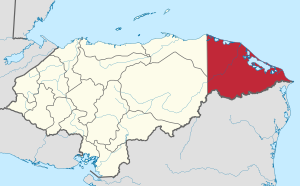Gracias a Dios Department facts for kids
Quick facts for kids
Gracias a Dios Department
Departamento de Gracias a Dios
|
|
|---|---|
|
department
|
|

Location of Gracias a Dios in Honduras
|
|
| Country | |
| Municipalities | 6 |
| Villages | 69 |
| Founded | 21 February 1957 |
| Capital city | Puerto Lempira |
| Government | |
| • Type | Departmental |
| Area | |
| • Total | 15,876 km2 (6,130 sq mi) |
| Population
(2015)
|
|
| • Total | 94,450 |
| • Density | 5.9492/km2 (15.4084/sq mi) |
| Time zone | UTC-6 (CDT) |
| Postal code |
33101
|
| ISO 3166 code | HN-GD |
| HDI (2017) | 0.526 low · 17th |
| Statistics derived from Consult INE online database: Population and Housing Census 2013 | |
Gracias a Dios (say "Grah-see-as ah Dee-os") means "Thanks to God" in Spanish. It is one of the 18 main regions, called "departments," in the country of Honduras. The main city and capital of this department is Puerto Lempira. Before 1975, the capital was Brus Laguna.
Contents
A Look Back in Time
Gracias a Dios was created in 1957. It was formed from a large area known as the Mosquito Coast. Parts of the Colón and Olancho departments were also included. This area is quite far away and hard to reach by land. However, small local airplanes can fly to the main cities.
Exploring the Geography
The Gracias a Dios department covers a large area of about 16,997 square kilometers (about 6,563 square miles). In 2015, about 94,450 people lived there.
Even though it is the second largest department in Honduras, not many people live there. It has huge areas of pine forests, wet swamps, and thick rainforests. Sadly, farming is growing in the area, which can threaten these beautiful natural places.
Natural Wonders
This department is home to the Caratasca Lagoon. This is the biggest lagoon in all of Honduras. A lagoon is a shallow body of water that is separated from the ocean by a barrier, like a sandbar.
Who Lives Here?
In 2013, a census counted 90,795 people living in Gracias a Dios. Most of the people (about 81%) are Indigenous. This means they are the original people of the land.
The largest Indigenous group is the Miskito, making up about 79.7% of the population. Other groups include the Mayangna. About 16% of the people are Mestizo, which means they have mixed European and Indigenous backgrounds. There are also smaller groups of Black or Afro-Honduran and White people.
Cities and Towns
The Gracias a Dios department is divided into six smaller areas called municipalities. Each municipality has its own main town or city.
See also
 In Spanish: Departamento de Gracias a Dios para niños
In Spanish: Departamento de Gracias a Dios para niños

